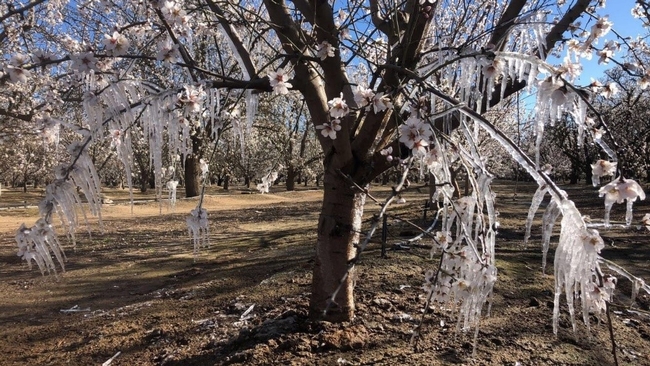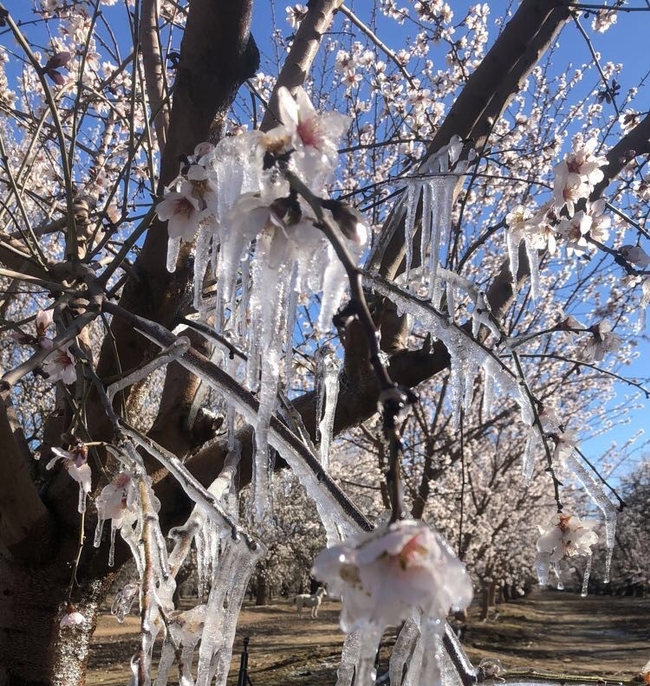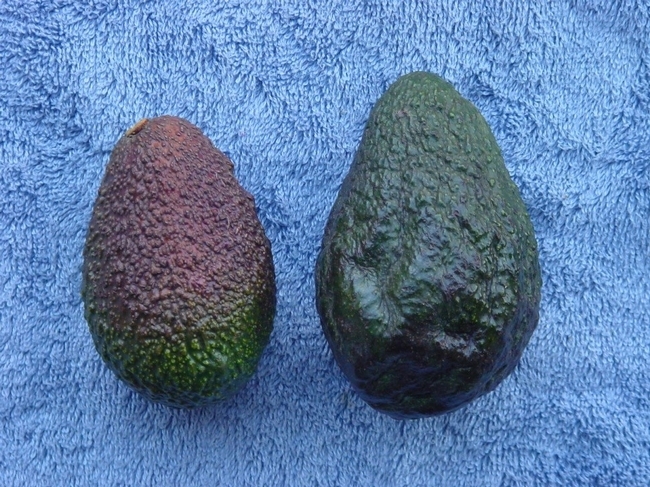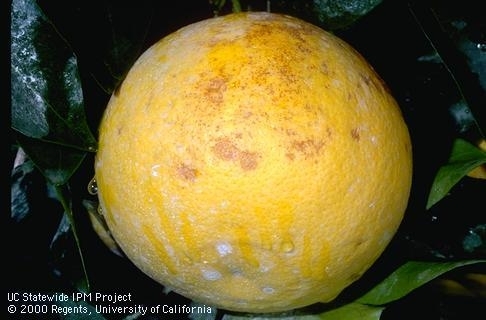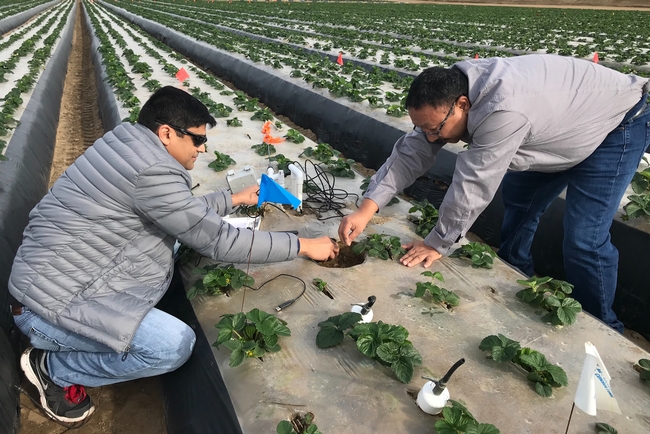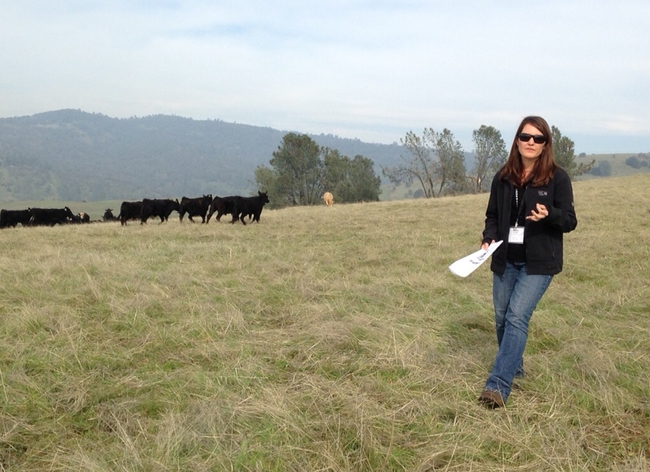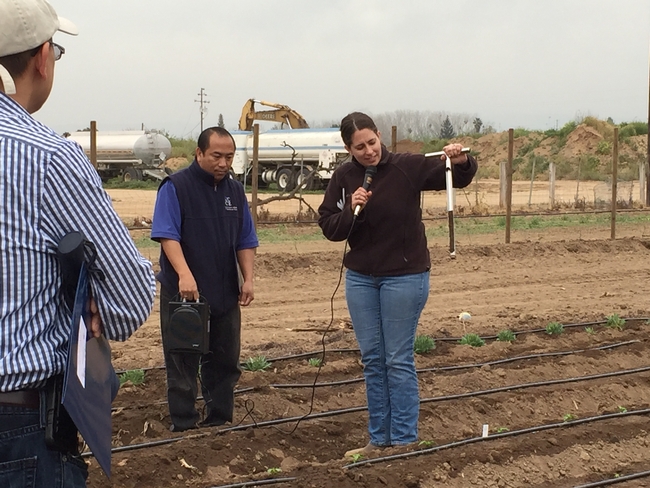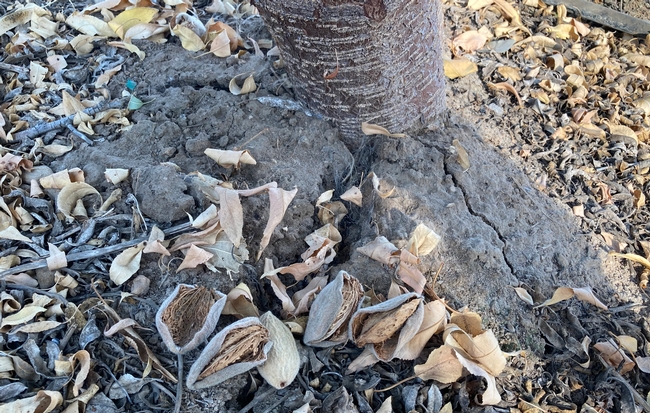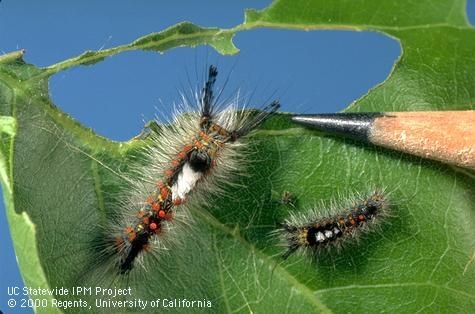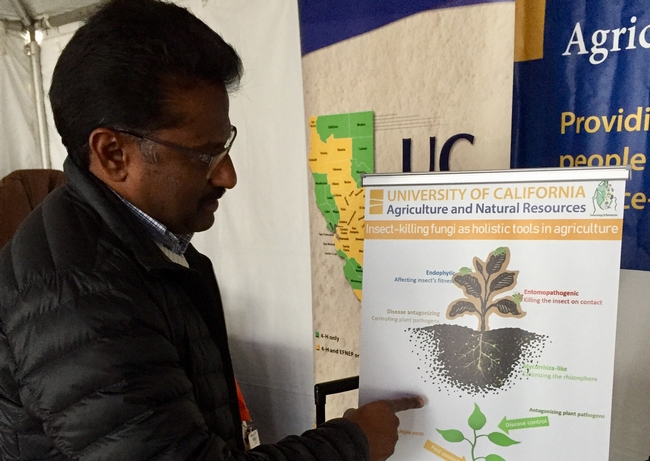Posts Tagged: Tapan Pathak
Climate change may reduce frost damage to orchard crops
CalAgroClimate web tools help farmers prepare for frost events
A cold snap damaged almond blossoms across the Central Valley, resulting in more than $44 million in crop insurance claimsin late February 2018. A multi-day frost event wiped out roughly 75% of California's citrus crop and severely damaged avocados in January 2007. Frost can damage crops, impact growers' bottom lines and drive up food prices for consumers. With advance notice, farmers may be able to use heaters, wind machines, irrigation and other tactics to lessen some of the impacts of cold weather, such as damaging near-ripe citrus fruit or killing the bloom in almonds.
CalAgroClimate is a new farmer-focused website that can help growers anticipate weather-related risks and make plans for taking defensive action. Growers and crop consultants can use CalAgroClimate's crop and location-specific tools and resources to help prepare for upcoming frost events. The website's tools can also support on-farm decisions for managing heat, crop development and pests.
Future holds less frost
The risk of frost damage to crops and the need to prepare for that risk is top-of-mind for many farmers today, but will it always be so? To examine what climate change might mean for future frost risk, researchers at UC Davis, UC ANR and the USDA California Climate Hub conducted a study examining the incidence of temperatures below multiple “frost thresholds” during the months of critical development phases for three frost-sensitive California crops: almonds, avocados and navel oranges.
The researchers found that even during the coldest winters and springs, the incidence of frost exposure declined under projected mid-21st century climate conditions by more than 50% for almonds and oranges, and by more than 75% for avocados. While farmers in 2050 will not find frost risk to completely be a worry of climates past, they will not have to contend with the same frost concerns that farmers face today.
Beyond the obvious benefits of reduced risk of crop damages, additional benefits of reduced frost exposure include lower water use and energy costs associated with mitigation actions. Irrigation is a primary means of protecting crops from frost temperatures, and with fewer hours below freezing that means fewer hours of running water and using pumps. The authors of the future frost exposure study showed that growers may collectively save tens of thousands of acre feet of water and enjoy millions of dollars in energy savings.
Few aspects of climate change are considered “positives,” and although the warming winters and springs that result in reduced frost temperatures could also come with increased pest pressure, reduced chill accumulation and other challenges, the reduction in frost exposure is a silver lining.
However, until this frost-free future arrives, growers still need to be prepared to protect their orchards from frost. To assess frost risk for the next seven days for your location, check out the new interactive Frost Advisory Tool at CalAgroClimate.org.
UC ANR scientists receive $1.5M NIFA grant for climate-smart agriculture
To help California farmers and ranchers adjust to uncertain weather and climate events, the USDA National Institute for Food and Agriculture has awarded $1.5 million to a team of scientists led by UC Agriculture and Natural Resources. The project is one of six projects funded by USDA NIFA's $9 million investment to expand adoption of climate-smart practices.
“The Cooperative Extension system and the USDA Climate Hubs have unmatched capacity to reach agricultural, Tribal and underserved communities, as well as educators and students, and our nation's farmers directly,” said Agriculture Secretary Tom Vilsack in a statement announcing the grant recipients. “This partnership will strengthen climate research efforts and accelerate the development, adoption and application of science-based, climate-smart practices that benefit everyone.”
California has the largest and the most diverse agricultural economy in the nation, with revenue exceeding $50 billion, which is larger than the revenues of the other 10 Western states combined. Despite its size, the state is highly vulnerable to climate change.
“California farmers and ranchers need locally relevant climate information and adaptation resources,” said Tapan Pathak, UC Cooperative Extension specialist based at UC Merced and principal investigator for the grant. “Similarly, technical service providers are often ill-equipped to assist farmers and ranchers when asked questions about climate change, weather variability and local implications to implement those decisions.”
To train the next generation of workers to be climate-ready, colleges expose students to climate science and agricultural science separately, but often lack opportunities for the students to learn about the nexus of climate and agriculture.
Pathak plans to provide classes – along with opportunities for practical learning experiences – to farmers, ranchers, agricultural service providers and students.
“An overarching goal of this project is to develop robust multifaceted pathways to climate-smart agriculture by integrating Extension and participatory education program development and delivery to enhance agricultural resilience to climate change,” he said.
“To tackle this ambitious goal, we have a large team of multidisciplinary leading scientists and experts from local, state and federal agencies, the California Climate Hub and the University of California ready to work with diverse stakeholder groups.”
UC Cooperative Extension specialists Leslie Roche, Vikram Koundinya and Daniele Zaccaria at UC Davis; Mark Cooper, UC Davis professor; and Steven Ostoja of the USDA California Climate Hub, are co-principal investigators with Pathak.
They will begin with a needs assessment for all of their stakeholders, including socially disadvantaged farmers and ranchers. Through three components, the project team will work to understand growers' perception of climate change-related threats, build capacity for technical assistance providers to advance climate-smart agriculture research and delivery of science-based information, and educate community college and undergraduate university students.
Engaging with farmers and ranchers
With the help of community partners including the Community Alliance of Family Farmers and the California Association of Resource Conservation Districts, the team will reach out to socially disadvantaged and limited-resource producers, including beginning and first-generation farmers and ranchers to attend regional workshops, led by instructors who are fluent in Spanish and Hmong.
Workshop content will address a broad range of topics including climate change trends and local impacts, drought planning strategies, optimization of agricultural productivity with limited resources and farm and ranch economic sustainability.
“California has so much diversity in terms of scale, crops, geography, micro-climates, market conditions and natural resource considerations that a one-size-fits-all approach will not work,” wrote Renata Brillinger, CalCAN executive director, in her letter supporting the project. “We support your plans to address the needs of producers though region-specific workshops.”
Five county-based UC Cooperative Extension academics will serve as regional leads for the farming workshops across broad geographic regions:
- Andre Biscaro, UCCE irrigation and water resources advisor serving Ventura County
- Ruth Dahlquist-Willard, UCCE small farms advisor for Fresno and Tulare counties
- Surendra Dara, UCCE entomology and biologicals advisor serving San Luis Obispo and Ventura counties
- Jairo Diaz, director of the UC Desert Research and Extension Center in Southern California
- Jhalendra Rijal, UCCE integrated pest management advisor serving San Joaquin and Merced counties
Workshops for ranchers and rangeland managers will be coordinated by UCCE rangeland and livestock advisors in their respective regions:
- Dan Macon, UCCE livestock and natural resources advisor for Plumas, Nevada, Sutter and Yuba counties, will organize workshops for the Sierra Nevada mountains and foothill region
- Grace Woodmansee, UCCE livestock and natural resources advisor for Siskiyou County, will organize workshops in Northern California
- Rebecca Ozeran, UCCE livestock and natural resources advisor for Fresno and Madera counties, will organize workshops in Central California
- Devii Rao, UCCE livestock and natural resources advisor for Monterey, San Benito and Santa Cruz counties, will organize workshops in the coastal region
- Brooke Latack, UCCE livestock advisor for Imperial, Riverside and San Bernardino counties, will organize workshops in Southern California
Training technical service providers
The team will offer climate-smart agriculture trainings for technical service providers on how to prepare for key stressors in California agriculture such as floods, droughts, wildfires and heatwaves; effective climate communications; invasive pests and disease management under future climate; and weather and climate resources and decision support tools for managing risks.
One of the aims of this component is to encourage more coordinated efforts among different agencies to deliver climate change resources to their respective stakeholders, Pathak said.
California Cattlemen's Association has expressed its support for the project.
“Given ranchers' strong relationships with and reliance upon technical services providers – particularly those housed within the USDA and University of California – CCA also sees great value in the project's goal of building capacity within those organizations to assist ranchers in addressing the challenges of climate change,” wrote Kirk Wilbur, CCA vice president of government affairs.
Nurturing future generations
For college students, there will be the UC Merced Summer Institute on Climate and Agriculture certificate course organized by Karina Diaz Rios, UC Cooperative Extension specialist based at UC Merced; the UC Davis credit-based course “Science and Society: Climate Change and Agriculture;”and a certificate course for community college students, which will be overseen by the Bay Area Community College Consortium of 28 colleges.
“We will join you in this exciting work and shared vision towards inclusive education in climate resilient agriculture,” wrote Nancy Gutierrez, statewide director of the Agriculture, Water, Environmental Tech sector of the California Community College System.
Students from the three courses will be selected for paid summer internships to engage in Cooperative Extension projects.
“Through climate-smart agriculture education, the workforce will be prepared to advance climate science and research efforts for future generations,” Pathak said.
A hike in navel orangeworm pressure expected later this century due to climate change
Outsized wildfires, rising sea levels and disappearing glaciers are dramatic signs of climate change, but not the only ones. New UC Agriculture and Natural Resources research provides forewarning of a change that will be economically and environmentally costly to California – a fifth generation of navel orangeworm, the most destructive pest of almonds, walnuts and pistachios.
Navel orangeworm (NOW) will be more problematic in the future because of warming temperatures, UC Cooperative Extension scientists report in Science of the Total Environment.
Like most insects,NOW's development rate, physiology, behavior and reproduction are highly dependent on the ambient temperature. When the weather warms in the spring, NOW moths emerge from the nuts left in the tree or on the ground during the winter. After mating, females then recycle those last year's nuts to lay eggs and complete one generation. Adults emerged from that first and subsequent generations then lay eggs on in-season hull-splitalmondnuts, where larvae feeding damages the crop. Typically the pests fly three to four times per year – with more flights in areas with warmer weather.
“Warmer temperatures can result in early activity of the pests in the spring and increased activity during the season,” said Tapan Pathak, the UC Cooperative Extension climate change specialist and the study's principle investigator.
The scientists looked at 10 climate models to determine what nut farmers can expect to face over the next 80 years and applied NOW developmental models to the changing climate. Daily maximum and minimum temperature data were obtained for 1950 to 2005, and future projections stretched to 2100.
“The fifth generation can happen in the next few decades,” said Jhalendra Rijal, UC integrated pest management advisor and co-author of the research. “The climate models suggest that spring will begin earlier. That causes insect activity to start earlier. With increased temperatures through the season, the number of days to complete a generation is less. At the end of 2050 or so, we'll see an extra generation.”
The study focused on 23 counties in the Central Valley, from Shasta County in the north to Kern County in the south, where 1.78 million bearing acres of nut crops are planted. About two-thirds of that acreage is planted to almonds, 20% in walnuts and 16% in pistachios. The tree nut crops were valued at more than $8 billion combined in 2018, according to the California Department of Food and Agriculture.
The completion of the NOW life cycle is faster in pistachio compared to almonds and walnuts, so the potential risk of crop damage and economic loss is higher in pistachio, according to the research report. There are only a few years historically in which the models detected the fifth generation of NOW in Kern County pistachios. The occurrence of the fifth generation in almonds and walnuts was historically nonexistent, but it starts appearing in three southern counties by 2040 and eleven counties by 2100.
“In order to alleviate some of the risks related to navel orangeworm damage to nut crops, it is important to implement integrated pest management practices,” Pathak said.
IPM preventative and control measures include sanitizing the orchard during the winter by removing all the nuts on the ground and in the trees, applying synthetic reproductive hormones to limit the pests' ability to find mates, encouraging natural enemies, judicious of least-toxic pesticides if necessary and harvesting the crop early to avoid a new generation of the pest.
“A better understanding of future navel orangeworm pressure on California's major nut crops can help facilitate and strategize integrated pest management practices in order to minimize production risks,” Pathak said.
The results of the research can also inform growers and pest control advisers about the potential increased threat from other pests as the climate changes.
ANR in the news April 19-30
CDFA awards grant for Proactive IPM program
(Morning Ag Clips) April 30
The California Department of Food and Agriculture has awarded funding for one project in the initial funding cycle for the Proactive Integrated Pest Management (IPM) Solutions grant program. The project, titled “Proactive Biological Control of Spotted Lantern Fly, Lycorma delicatula (Hemiptera: Fulgoridae)” was awarded $543,936.
The three-year project will develop biological control agents for spotted lantern fly, an invasive pest that has not yet arrived in California but is spreading rapidly across the eastern US. This pest has the potential to affect many high-value California crops including grapes, walnuts, avocados, and pistachios. The project will piggyback on work that is already being conducted on the pest in the eastern US and abroad. Project leads are Dr. Mark Hoddle (UC Riverside) and Dr. Kent Daane (UC Berkeley). The biological control agent is a small (3 mm) stingless wasp, native to China, that parasitizes the eggs of the spotted lantern fly.
https://www.morningagclips.com/cdfa-awards-grant-for-proactive-ipm-program
Learn about sheep, shearing, and more at Barn to Yarn in Hopland this week
(MendoVoice) April 30
If you've ever wondered how a sheep's wool becomes a sweater, you might want to check out the "Barn to Yarn" event in Hopland this weekend. This popular springtime event will return to the University of California Hopland Research and Extension Center this Saturday, May 4.
The Barn to Yarn event will feature farmers and ranches, shearers, spinners, weavers, and knitters, and other local experts involved in the Northern California sheep industry. There will educational activities, presentations, workshops, take-home craft activities, and more for all ages.
Moth caterpillars are back for a rare second bite in the Bay Area
(Mercury News) Cat Ferguson, April 29
…Andrew Sutherland, University of California Cooperative Extension's urban integrated pest management adviser for the Bay Area, recommends a simple preventive measure: reach for the hose.
Right after the bugs have hatched, “use pressure washers to push the larvae off the trees before they start wandering around,” he said. “In the late summer and fall, if you've got egg masses, you can wash them off and you won't have an issue next year on that tree.”
Bay Area pest control and horticulture experts say most caterpillar calls come from Santa Clara and southern San Mateo counties, which Sutherland linked to warm weather and high densities of host plants — the caterpillars are particularly fond of oak and fruit trees. Sutherland said he doesn't field nearly as many calls from the East Bay.
https://www.mercurynews.com/2019/04/29/san-jose-moth-boom/
Hopland Research Center holds BioBlitz for Mendocino County students
(Ukiah Daily Journal) Curtis Driscoll, April 26
The Hopland Research and Extension Center held its annual “BioBlitz” on Friday for over 200 students from across Mendocino County, giving them a chance to explore their interest in science by finding new species at the Hopland Research Site.
The BioBlitz went on at the same time as the 2019 City Nature Challenge, an international event where people find and document plants and wildlife in cities across the globe. Although students in Mendocino County couldn't participate in the national event, the Hopland Research Center decided to have the BioBlitz as a way to allow students to explore nature in Mendocino County.
…Experts also helped the students learn more about the area in Mendocino County and the many kinds of unique species that are in the county. Anna Holmquist, an arachnologist from UC Berkeley, entomology students from UC Berkeley, and California Naturalists, people who have gone through a UC naturalist training program, were all available throughout the day to help students and guide them as they made different discoveries.
“We will be looking for species with them and searching and trying to add to the list, but there will be a bit more depth to it with the kids actually trying to build on their understand of our Mendocino habitats,” said Hopland Research Center Community Educator Hannah Bird.
Have the Tough Conversations: Koopmann Family Ranch Transfer
(Capital Press) Ashley Rood, April 26
… The next generation of Koopmanns, Carissa and Clayton, are well-poised to continue the family legacy of conservation and ranching. Both are building up their own cow herds on leased land while, as partners in the family LCC, they help make the big decisions. They also have full-time agriculture jobs off the ranch focused on grazing. Clayton is the range manager for the local water utility, the SFPUC, and has a grazing management consulting business. Carissa is a livestock and natural resources advisor for University of California Cooperative Extension in Siskiyou County. Both Carissa and Clayton emphasize how hard it is to make a living ranching alone, even with all the advantages of the family ranch. But getting out on the land, despite the hard work, is a place of relaxation for both of them.
For others considering succession planning, Carissa says, “Get started early and don't ever make assumptions. It's vital to know what everybody truly wants. Ultimately, the end goal that is that you're still a family, regardless of what happens.”
Fresh, local and sustainable advice
(Marin Independent Journal) Jane Scurich, April 26
Ah, spring! Time to visit the local farmers market for tender locally grown asparagus, luscious spring peas and great gardening advice. Wait — what's that last item — advice? Yes — and it's free!
Knowledgeable, UC-trained volunteers in the University of California Marin Master Gardener program officially open their market advice tables in May to provide research-based information on horticulture and sustainable gardening practices to Marin residents.
https://www.marinij.com/2019/04/26/fresh-local-and-sustainable-advice/
Love science? Free app allows you to assist in research!
(ABC10) Monica Woods, April 25
…In the words of Laci Gerhart-Barley, iNaturalist is "Instagram for biology and nature enthusiasts." The professor with the biological services department at the University of California, Davis, is even incorporating it into her classroom.
… Each year iNaturalist users participate in a "competition" to see what region can upload the most photos in the matter of a few days. The City Nature Challenge started as a competition between the California Academy of Sciences in San Francisco and the Los Angeles County Natural History Museum and gradually grew to include regions all over the world.
The Sacramento region is getting on board for the first time in 2019. [Sarah Angulo, community education specialist for the California Naturalist Program, is helping organize the challenge.]
The City Nature Challenge Sacramento will take place from Friday, April 26 to Monday, April 29.
UC Extension head updates supervisors on programs and leaders
(Plumas News) Victoria Metcalf, April 24
The face of the Farm Advisor's office is changing.
Plumas and Sierra county Farm Advisor Director David Lile was before the Plumas County Board of Supervisors April 9, explaining just how much his staff has changed.
… Holding up a copy of the local University of California Agriculture and Natural Resources annual report for last year, Lile said, It's “easy to look at with plenty of pictures.”
…Lile then introduced Ryan Tompkins as the new forestry advisor. He replaces longtime representative Mike DeLasaux who retired in 2018.
…Natural resources and livestock liaison with local ranchers was introduced next. That's Tracy Scholr [Schohr].
…Most 4-H members and their parents already know 4-H Program Representative Kari O'Reilly.
… Tom Getts was also introduced as the technical assistance for Plumas and Sierra farmers and Susanville area land managers.
… And Barbara Goulet, as administrative assistant, provides support to the staff, but also works with local Master Gardener volunteers and 4-H volunteers, according to Lile.
http://www.plumasnews.com/uc-extension-head-updates-supervisors-on-programs-and-leaders/
Can California get cows to burp less methane?
(NBC News) April 24
California is now requiring the beef and dairy industry to reduce its greenhouse gas emissions. Some scientists are testing and growing a red algae seaweed that can reduce methane from cow burps.
https://www.nbcnews.com/leftfield/video/can-california-get-cows-to-burp-less-methane-1506967107599
How to Control Thrips in Blueberries
(California Fresh Fruit) Matthew Malcolm, April 24
Citrus thrips have been a major nuisance for California blueberry growers, but how do you keep them under control and when should you apply crop protection materials? Is there an organic treatment available? Watch this brief interview UC Cooperative Extension Farm Advisor David Haviland as he answers all these questions. Read more about blueberry pest management in California Fresh Fruit Magazine.
https://calfreshfruit.com/2019/04/24/how-to-control-thrips-in-blueberries/
UC: Older vineyards can be modified for mechanization
(Ag Alert) April 24
Saying they have proven that older vineyards can be converted to mechanization, University of California Cooperative Extension specialists say winegrape growers in the San Joaquin Valley do not have to replant vineyards if they want to switch to mechanical pruning.
Growers who want to make the switch can retrain the vines to make the transition, without losing fruit yield or quality, according to a UCCE study.
UCCE specialist Kaan Kurtural said the study found that "growers do not have to plant a new vineyard to mechanize their operations."
"We have proven beyond a doubt that an older vineyard can be converted to mechanization," he said.
There is no loss in yield during conversion, Kurtural said, "and post-conversion yield is better and fruit quality is equivalent to or better than hand-managed vines."
http://agalert.com/story/?id=12932
No replanting needed for mechanical pruning
(Farm Press) Tim Hearden, April 24
University of California (UC) researcher Kaan Kurtural has gained recognition in recent years for automating a vineyard operation in the Napa Valley, which was planted at a density conducive to the practice.
Now Kurtural and other UC Cooperative Extension scientists are applying their knowledge in the San Joaquin Valley, where they say growers who wish to switch from hand to mechanical pruning to save labor won't have to replant to do so.
https://www.farmprogress.com/grapes/no-replanting-needed-mechanical-pruning
Wet winter in Sonoma County may have helped spread virulent oak disease
(Press Democrat) Derek Moore, April 24
Now that the North Coast is finally drying out from an unusually wet winter, concern is growing over the potential rapid spread of sudden oak disease, renewing calls for the public's help tracking the deadly forest pathogen.
“Now is when we might expect the pathogen to take off a bit,” said Kerry Wininger, a UC Cooperative Extension staffer in Santa Rosa.
Wininger is a local organizer of annual sudden oak death surveys known as the SOD Blitz. This year's survey occurs from April 25 to 28 across Sonoma and Mendocino counties. Organizers are hoping for a good turnout of volunteers, who will become educated spotters and collectors to help scientists slow the disease's spread.
https://www.sonomanews.com/lifestyle/9531662-181/wet-winter-in-sonoma-county
Young chefs: Local students prepare and taste international meals at fourth annual Culinary Academy
(Lompoc Record) Lorenzo J. Reyna, April 24
Twenty-one elementary school students spent part of their spring break learning to cook various international recipes inside Rice Elementary School's cafeteria Wednesday.
The fifth- and sixth-graders from 4-H Student Nutrition Advisory Council Clubs took part in the fourth annual Culinary Academy, spearheaded by six adults from UC CalFresh Healthy Living.
…Janelle Hansen helps oversee the 4-H SNAC Clubs as supervisor of the Santa Barbara and San Luis Obispo group.
She said Wednesday's five-hour event from 1 to 6 p.m. was much more than just students learning how to create various dishes.
“The hope is that they will learn the life skill of healthy living and nutrition — and that's really one of our goals,” Hansen said as the students were preparing their meals.
Close to home or farther afield, visit California's native plants and gardens
(Los Altos Online) Tanya Kucak, April 24
If you're in the mood for some road trips, immerse yourself in an atmosphere of beautiful plants and enthusiastic people by attending the Going Native Garden Tour, now in its 17th year.
Sponsored by the California Native Plant Society in association with the UC Cooperative Extension Master Gardeners of Santa Clara County, the tour offers an unparalleled chance to talk with gardeners and designers, view gardens of different types and compare gardens planted a year ago to those planted a couple of decades ago. More than 50 gardens are scheduled to be open 10 a.m. to 4 p.m. May 4 and 5. Gardens in San Jose and other southern Santa Clara County cities will be open May 4, while May 5 will feature visits to northern gardens from San Mateo to Sunnyvale, including Mountain View. No Los Altos gardens will be on display this year.
https://www.losaltosonline.com/news/sections/magazine/59930-
AgriTalk: How Agriculture is Managing High-Level Issues
(Agweb.com) Ashley Davenport, April 23
Dr. Frank Mitloehner of the University of California-Davis recently was awarded the 2019 Borlaug Council for Agricultural Science and Technology (CAST) award. He talks about what that award means for him, how he started on social media, and greenhouse gas emissions.
https://www.agweb.com/mobile/article/agritalk-how-agriculture-is-managing-high-level-issues/
Mechanical Vineyard Pruning Possible Without Replanting
(AgNet West) Brian German, April 23
One of the major concerns regarding mechanical vineyard pruning is the time and cost associated with replanting a vineyard in a manner that would accommodate the process. However, a report from University of California Cooperative Extension researchers that was published in HortTechnology demonstrates that replanting is not necessary. Research conducted in Madera County found that growers can mechanize their operations by retraining vines without suffering any fruit loss or decline in quality.
“The trial actually ran for three years,” said Kaan Kurtural, UC Cooperative Extension specialist in the UC Davis Department of Viticulture and Enology. “In the end, there was like no loss in yield even during the conversion years and the quality was actually much better in the mechanically managed plants.”
http://agnetwest.com/mechanical-vineyard-pruning-without-replanting
Is a small farm or ranch your dream? The Beginning Farming Academy is for you!
(Yuba Net) April 23
Is your dream to start a small farm or ranch? Are you ready to get started on your dream? Apply for the Beginning Farming Academy offered by the University of California Cooperative Extension on April 26th and 27th, 2019. The class is held in Auburn and runs from 8 AM to 8 PM on Friday, April 26th, and from 8 AM to 5 PM on Saturday, April 27th. April 23 is the application deadline for the April class.
The Academy is an intensive 2-day introduction to starting a small commercial farm or ranch and will help prospective farmers jumpstart their operations. “Participants will learn to assess their land and resources, research markets, and analyze the potential economic viability of their operation,” says Dan Macon, Livestock and Natural Resources Advisor.
California's high-value crops, like fruits and nuts, are the ones most vulnerable to climate change
(Fast Company) Larry Buhl, April 22
Agronomy, a peer-reviewed, open access scientific journal, laid out a stark future for California agriculture, predicting it will be vastly different by the end of the century. Led by Tapan Pathak of the University of California, Merced, the research team concluded that almost all of California's crops, together valued at more than $50 billion a year, will be endangered by rising temperatures and unstable weather patterns brought by climate change. The state will face wildly fluctuating precipitation patterns, leading to severe droughts and flooding, warming temperatures, more heat waves, and shorter chill seasons. The researchers wrote that the increased rate and scale of climate change “is beyond the realm of experience for the agricultural community,” and that changes in the state's crop output “would not only translate into national food security issues, but also economic impacts that could disrupt state and national commodity systems.”
Michael previews the UCCE Annual Spring Garden Tour
(Fox 26) Stephen Hawkins, April 22
The University of California Cooperative Extension Fresno County Spring Garden Tour & Plant Sale takes place this weekend.
Michael Ikahihifo spent the morning at Garden of the Sun on Earth Day to give us a preview.
https://kmph.com/great-day/michael-in-the-mix/michael-previews-the-ucce-annual-spring-garden-tour
California Has Farmers Growing Weeds. Why? To Capture Carbon
(KQED) Lauren Sommer, April 22
…“I think there's great potential for agriculture to play a really important role,” says Kate Scow, professor of soil microbial ecology at UC Davis, of the state's climate goals. She's standing in a large wheat field at Russell Ranch, seven miles west of the campus, where the university plants crops to study sustainable agriculture.
“Soil is alive,” she says. “There's farmers that know that.”
https://www.kqed.org/science/1940561/california-has-farmers-growing-weeds-why-to-capture-carbon
California farmers try new strategy to cut carbon
https://www.npr.org/2019/04/27/717756929/california-farmers-try-new-strategy-to-cut-carbon
Mitloehner To Receive CAST Award
(Drovers) Greg Henderson, April 19
Frank Mitloehner has been chosen by the Council for Agricultural Science and Technology (CAST) as 2019 Borlaug CAST Communication Award recipient. A professor and air quality extension specialist in the Department of Animal Science at the University of California-Davis, Mitloehner is the 10th recipient of this award.
“I'm honored to be selected by CAST, an org I've long admired, and to be in the company of so many recipients who have inspired me during my career,” Mitloehner said. “Being recognized with the Borlaug CAST Communication Award is an affirmation of the importance of sharing research and academic pursuits well beyond labs, classrooms and universities.”
https://www.agweb.com/article/mitloehner-to-receive-cast-award/
ANR in the news March 1-11
Western Innovator: Putting biologicals to work
(Capital Press) Padma Nagappan, March 11
Early in life, Surendra Dara decided that no matter which field he chose, he needed to make an impact on it. Always interested in science, he chose agriculture and specialized in entomology.
“It attracted me because it dealt with arthropods and there are a lot of physiological similarities to the human world,” Dara said. “It was also critical for growing food and feeding humans.”
Dara is now an entomopathologist with the University of California's Division of Agriculture and Natural Resources in San Luis Obispo, and has an established reputation for exploring innovative options to control pests using microbials as biological controls, and showing growers how they can also help with plant growth, drought resistance and fighting diseases.
Group linked to Ocasio-Cortez seeks ag input after Green New Deal backlash
(Politico) Helena Bottemiller Evich, March 11
After watching that drama unfold, Frank Mitloehner, a leading scientist on agricultural emissions at the University of California, Davis, was thrilled when two outreach staff affiliated with AOC's network reached out to set up a call to discuss the potential for climate mitigation efforts in agriculture. The call, held earlier this month, lasted more than an hour, Mitloehner said.
“I was very glad to inform of what I know, and they were very receptive to it,” Mitloehner said on Agri-Talk last week. During the segment, he urged agricultural producers to not dismiss the left-wing climate effort.
Sudden surge in an unusual crime in Fresno County: Goat theft
(LA Times) Hannah Fry, March 11, 2019
…Picquette's two sons have been raising goats for the last five years as a 4-H project. Losing their animals has been especially hard for the boys, Picquette said, adding that they had planned to use money won during competitions to pay for college.
“They feel very violated. They don't understand how somebody could just come and take something they worked so hard for,” she said. “The bond we have with the goats is incredible. I'm just heartbroken. I don't know if they're scared or hungry. … They've always been treated so well.”
https://www.latimes.com/local/lanow/la-me-ln-fresno-goat-theft-20190311-story.html
California's ambitious plan to stop deadly wildfires may not be enough, experts say
(SF Chronicle) Kurtis Alexander, March 9
… “It's not fair to say that fuel treatments won't do any good,” said Max Moritz, a UC Cooperative Extension wildfire specialist at UC Santa Barbara. “It may provide some protection in some places. But most of us studying this agree that you can't just do this and (expect to) make much headway.”
The plan by the California Department of Forestry and Fire Protection, or Cal Fire, comes at the request of Gov. Gavin Newsom. On his second day in office, Newsom asked the agency to develop a proposal to address the increasingly destructive fire seasons that have rattled the state and are expected to worsen with climate change.
…In the meantime, many researchers say the most effective approach to fire protection is not in the forests, but in communities. They recommend making homes more resistant to fire with hardier construction materials, and clearing the vegetation around them.
“You have to address the home vulnerabilities themselves,” said Moritz at UC Santa Barbara. “If you don't, you're just not going to make a lot of progress on fire.”
After more than 140 years, a massive fig tree gracing the plaza where Los Angeles was founded collapses
(LA Times) Matthew Ormseth, March 9
… The four figs were planted at El Pueblo by agriculturalist and City Councilman Elijah Hook Workman, KCET reported in 2013. The Ficus macrophylla was brought from Australia to Southern California in the 1860s and 1870s, probably to provide shade and ornamentation, said Donald Hodel, a horticulture advisor for the University of California's Cooperative Extension.
Hodel described the Moreton Bay fig as a commanding breed of tree with an enveloping canopy that threw plenty of shade.
His reasons for admiring the Moreton Bay fig: “Their grandeur; their size — they have an imposing habit; their root structure is incredible; the spreading nature of their branches.”
Hodel said he last saw the El Pueblo figs about six years ago.
“I wasn't too impressed by their health or their size, considering they're 140-something years old,” he said.
https://www.latimes.com/local/lanow/la-me-pueblo-tree-falls-20190309-story.html
California's 2018 Was the Worst Ever Recorded for Wildfires
(Gizmodo) Tom McKay, March 9
University of California, Santa Barbara UC Cooperative Extension wildfire researcher Max Moritiz told the Chronicle, “It's not fair to say that fuel treatments won't do any good. It may provide some protection in some places. But most of us studying this agree that you can't just do this and (expect to) make much headway.”
https://earther.gizmodo.com/californias-2018-was-the-worst-ever-recorded-for-wildfi-1833180368
4-H leader who taught lost Benbow girls outdoor skills being flown to Washington, DC for recognition
Kym Kemp, March 7
When Leia Carrico, age 8, and her sister, Caroline, age 5, disappeared into the woods around their home near Benbow on March 1, the whole nation held its breath for the next 44 hours until they were found. But, though their 4-H leaders were worried, too, they say they also knew the girls had something many other children don't–they had survival skills from a class taught by their Outdoor Adventures 4-H project leader, Justin Lehnert.
Lehnert is being honored in Washington, DC, on Tuesday for his role in teaching Leia and Caroline outdoor skills.
Researchers highlight plan to eat healthy on a budget
(Consumer Affairs) Kristen Dalli, March 7
Following a healthy diet can come with a hefty price tag, but a team of researchers has outlined a way for consumers to stick to a healthy diet -- and also stick to their budgets.
According to the team, consumers -- and their families -- can have healthy meals if they focus on buying items in bulk and planning meals in advance.
“This study determines the likelihood that families living in low-income households could create meals that meet the USDA dietary guidelines presented in MyPlate nutrition education materials,” said researcher Karen M. Jetter, PhD. “In addition to food cost, the other factors considered were access to stores, time for meal preparation, and whether the menus included culturally appropriate foods.”
Healthy eating is possible on a limited budget, study shows
Study: Eating healthy on a budget is possible
https://www.upi.com/Study-Eating-healthy-on-a-budget-is-possible/9951551904010/
Eating Healthy Is Possible on a Small Budget, Says Study
https://www.askmen.com/news/sports/eating-healthy-is-possible-on-a-small-budget-says-study.html
Sorry, Alexandria Ocasio-Cortez, but “farting cows” aren't the problem
(New Food Economy) Sam Bloch, March 7
…As it turns out, neither side was accurate. Republicans are likely to continue linking Green New Deal priorities to a supposed hamburger ban. But if you don't hear about cow farts anymore from AOC, it may not be because of GOP criticism. Frank Mitloehner, an animal scientist and air quality specialist at the University of California, Davis, insists cattle flatulence isn't the problem it's made out to be, and says he helped set the record straight.
Here's what seems to have happened. On February 4, shortly before Ocasio-Cortez announced the Green New Deal, she was speaking to school children in Queens, New York. When one asked how they could “combat” climate change, Ocasio-Cortez offered two practical options—stop using disposable razors, and skip meat and dairy for one meal.
Mitloehner tweeted at her.
“Dear @AOC: we all try to help the climate,” he wrote. “However, the two options you offered have low impacts compared to the 800lb gorilla, which is to reduce fossil fuel use. About ? of greenhouse gas emissions in the US stem from transport and energy prod&use. Meat/milk = 4 % of total GHG,” referring to findings in a recent EPA report.
… “I give her team a lot of credit for reaching out,” Mitloehner says. “If we really are serious about making a difference in carbon emissions, you cannot do this without agriculture involved.”
California supplies a quarter of the world's sunflower seeds
(Capital Press) Padma Nagappan, March 7
…Khaled Bali is a University of California Department of Agriculture and Natural Resources statewide water and irrigation specialist who has been working since 2016 on a four-year trial on sunflower varieties.
He was asked by the University of Georgia to help ascertain which varieties were drought resistant. He chose to conduct his trial in the low desert region of the Imperial Valley, since it gets little rain during the growing season between February when it's planted, and June when it's harvested. This would make it easier to control and measure the actual water applied to the crop varieties.
“We're looking at 285 varieties of sunflowers, to see which ones do well under stress,” Bali said. He has tested different plantings each growing season for the past three years, and will finish the trial this year.
https://plantingseedsblog.cdfa.ca.gov/wordpress/?p=17375
Livestream coverage of fire protection panel discussion in Nevada City
(Sierra Sun) March 7
…Following the films, the community is invited to join an ongoing conversation around the new reality of living with fire in the wildland urban interface. Panelists represent a diverse cross-section of the wildfire prevention community including: Cal Fire, Fire Safe Council of Nevada County, Nevada County Office of Emergency Services, Nevada County Resource Conservation District, Pacific Gas and Electric Company, Tahoe National Forest and University of California Cooperative Extension. The panel discussion will be moderated by YubaNet Co-founder Pascale Fusshoeller. [Kate Wilkin, UCCE fire advisor, participates on the panel in the last hour of the video.]
Bees, blooms off to slow start
(Western Farm Press) Logan Hawkes, March 6
…This year, almond bloom started around a normal time, with some early varieties showing a few open flowers in the first week of February,” reported Franz Niederholzer, UCCE farm advisor for Colusa, Sutter, and Yuba Counties. “For most of the month bloom progressed very slowly,”
By the middle of February, he says, “bloom for Nonpareil was at least two weeks behind, and bee hours were limited until the last week of the month. Last year, between Feb 1-20, we accumulated 130 bee hours of good honey bee flying weather [55 F., no rain, and wind less than 10 mph]. For the same interval this year, we had around 10 hours and only six of those occurred with open flowers in the orchard.”
On the positive side of the slow start, Niederholzer says, the colder weather tends to suppress activity of key bloom diseases such as blossom brown rot and anthracnose. “However, cold weather at bloom was conducive to blossom blast (pseudomonas) bacteria, and some growers were considering adding materials to their normal bloom fungicides with bactericide activity.”
https://www.farmprogress.com/tree-nuts/bees-blooms-slow-start
Wet winter aids groundwater replenishment
(Ag Alert) Christine Souza, March 6
… Helen Dahlke, a hydrology expert and professor with the University of California, Davis, Department of Land, Air and Water Resources, has been working with farmers, studying on-farm groundwater recharge locations and suitability for various crops.
"In many regions, we can definitely do more actively recharging our groundwater aquifers," said Dahlke, who currently has trials on alfalfa at the UC Kearney Agricultural Center. "It really depends on what region, how much surface water is available for recharge, what kind of sediment structure or hydrogeology we have underneath and whether it's suited for conveying large amounts quickly."
Despite abundant precipitation in recent weeks, she said the timing is not the best for studying impact of recharge on certain crops.
"We prefer on-farm recharge to happen in January and February, just because that is considered the dormancy season for most crops," Dahlke said. "With almond trees already blooming, often there is a greater risk of applying water on those crops."
She said recent precipitation has helped groundwater recharge overall, but there is "very little way of estimating how much it is helping."
http://www.agalert.com/story/?id=12797
Drip irrigation improves yields of Imperial sugar beets
(Ag Alert) Padma Nagappan, March 6
Halfway through a two-year irrigation trial to test furrow irrigation versus drip on sugar beet in California's Imperial Valley, Ali Montazar is looking for ways to boost yields with as little water consumption as possible in a region where furrow irrigation is the common practice.
Montazar, irrigation and water management advisor with the University of California department of agriculture and natural resources (UCANR) in Imperial County, is comparing and evaluating sugar beets for crop water use, sugar percentage, and yield, using both furrow and drip, since growers are now thinking of switching to subsurface drip.
Preliminary results from year one of the trial show that yield and crop water use are better with drip. Yield was 21 percent higher, and water use was a few points lower.
http://www.agalert.com/story/?id=12782
NFU says “No” to Green New Deal
(DTN) Jerry Hagstrom and Chris Clayton, March 6
Frank Mitloehner, an animal-science professor and air-quality Extension specialist at the University of California-Davis, reached out to Ocasio-Cortez's team about agriculture and the Green New Deal after seeing social media posts late last month about “farting cows” that drew a great deal of attention.
“I appreciate her interest in climate-change mitigation, but the 800-pound gorilla is the use of fossil fuels, and I told her that even the notion of cow flatulence makes this whole thing sound silly, and that's not what we need this discussion to be,” Mitloehner told DTN in an interview.
From Farting Cows to More Beans; Anti-Livestock Claims Fall Short
(AgriTalk) Jennifer Shike, March 5
The EAT-Lancet Commission on Food, Planet, Health is backpedaling as industry leaders and scientists poke holes in its “planetary diet” released in mid-January that is supposed to improve human health and planet health.
Air Quality Extension Expert Frank Mitloehner of the University of California Davis joined Chip Flory on AgriTalk Monday to discuss EAT-Lancet and Green New Deal in more depth.
4-H instructor who taught NorCal sisters how to survive in wilderness speaks out
(ABC7) Dion Lim, March 4
ABC7 News spoke exclusively to the 4-H instructor who taught two young girls the life-saving skills they needed to survive a weekend lost in the woods.
… Their mom, Misty Carrico, says she's not sure her daughters would have survived, if not for their 4-H program.
"The group leader Justin has taught them fire making skills and wilderness survival skills."
Justin Lehnert, the girls' 4-H leader, said, "I'm ecstatic that they did the job that they did. They're very strong girls and they stayed calm."
… Nine-year-old Caroline Gelormini has been a member of the San Bruno-South San Francisco 4-H Program for five years. Thanks to 4-H, she feels like she'd have a shot at surviving in the woods too.
Ocasio-Cortez Seeks Ag Data on Green New Deal
(Drovers) John Herath, March 4
When freshman congresswoman Alexandria Ocasio-Cortez released her Green New Deal plan, social media lit up with talk of her plan's mentions of “farting cows.” That drew the attention of agriculture's preeminent expert on air quality, Dr. Frank Mitloehner of the University of California at Davis, who tweeted back at the congresswoman.
“I don't know whether my tweet was the reason, but a few hours after I tweeted her, all mentioning of cow flatulence were taken off the web pages and of all social media outlets and was never to be heard again,” Mitloehner told Chip Flory on the AgriTalk Radio Show Monday.
https://www.drovers.com/article/ocasio-cortez-seeks-ag-data-green-new-deal
2 missing Humboldt County girls found — ‘absolute miracle
(SF Chronicle) Michael Cabanatuan, March 3
…Little additional information was available on how the girls went missing or how they survived, but Honsal said they had been trained in outdoors survival as members of a 4-H program.
https://www.sfchronicle.com/news/article/Absolute-miracle-as-missing-Humboldt-County-13659375.php
Organic farm east of Denair does its part on climate change. It's getting an award
(Modesto Bee) John Holland, March 2
…The family won in the farmer/rancher category of the Climate Leadership Awards. The others:
- Researcher: Tapan Pathak of the University of California Cooperative Extension in Merced, who helps farmers adapt to climate change.
- Policymaker: Ken Alex, who was director of former Gov. Jerry Brown's Office of Planning and Research
- Legislative staff: Brett Williams, office of Assemblywoman Jacqui Irwin, D-Thousand Oaks
- Agricultural professional: Ruth Dalquist-Willard, UC Cooperative Extension, Fresno
https://www.modbee.com/news/article226956529.html
Eructation Inflation: Greenhouse Gas Emissions of Livestock
(Science for the Rest of Us) March 1
Put your nerd hat on -- we cover a lot of ground in this fast-paced discussion with Dr. Frank Mitloehner of the University of California-Davis about the greenhouse gas emissions associated with the meat and dairy we consume. We consider how livestock emissions compare to other sectors of the US and global economies, the carbon footprint of vegetarian diets and what is the most effective way to reduce individual carbon emissions.
Keeping the Carbon Footprint of Livestock in Perspective
(AgNet West) Brian German, March 1
…“It is irresponsible and it's misguiding the public to believe that the true sources of pollution are downplayed, and the impacts of animal agriculture are grossly inflated,” said Dr. Frank Mitloehner, Professor and Air Quality Specialist in Cooperative Extension in the Department of Animal Science at the University of California, Davis.


